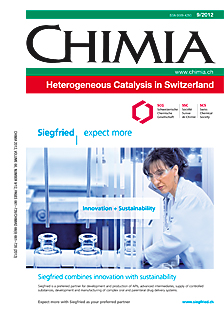Characterization of a Spent Ru/C Catalyst after Gasification of Biomass in Supercritical Water
DOI:
https://doi.org/10.2533/chimia.2012.706Keywords:
Carbon-supported ruthenium catalyst, Heterogeneous catalysis, Supercritical water gasification, Surface sensitive analysis, Wet biomassAbstract
Carbon-supported ruthenium catalysts promote the gasification of aqueous organic feed with high efficiency to synthetic natural gas in supercritical water. Ruthenium metal was recently identified as the catalytically active species. [1] Occasionally deactivation is observed. To understand the deactivation, the fresh and several spent catalyst samples were investigated by RBS, ERDA, and XPS. The data revealed a massive reduction of the ruthenium concentration in toto and especially of the surface concentration. Of importance is the almost complete disappearance of the spectral features in the valance band region. Coverage of the ruthenium clusters e.g. with a thin 'carbonaceous' layer, i.e. a kind of fouling, or structural modifications of the ruthenium clusters might be the origin. Additionally, leaching of ruthenium might contribute, but is not considered a major effect, because ruthenium was never found in the liquid effluent of the reactor. The influence of additionally detected corrosion products (Ni, Cr, Fe, Ti) from the stainless steel and the titanium alloy walls seems to be small. No evidence for a deactivation by sulphur could be found.Downloads
Published
2012-09-26
Issue
Section
Scientific Articles
License
Copyright (c) 2012 Swiss Chemical Society

This work is licensed under a Creative Commons Attribution-NonCommercial 4.0 International License.
How to Cite
[1]
J. Wambach, M. Schubert, M. Döbeli, F. Vogel, Chimia 2012, 66, 706, DOI: 10.2533/chimia.2012.706.







